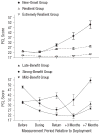Peace and war: trajectories of posttraumatic stress disorder symptoms before, during, and after military deployment in Afghanistan
- PMID: 23129059
- PMCID: PMC3893698
- DOI: 10.1177/0956797612457389
Peace and war: trajectories of posttraumatic stress disorder symptoms before, during, and after military deployment in Afghanistan
Abstract
In the study reported here, we examined posttraumatic stress disorder (PTSD) symptoms in 746 Danish soldiers measured on five occasions before, during, and after deployment to Afghanistan. Using latent class growth analysis, we identified six trajectories of change in PTSD symptoms. Two resilient trajectories had low levels across all five times, and a new-onset trajectory started low and showed a marked increase of PTSD symptoms. Three temporary-benefit trajectories, not previously described in the literature, showed decreases in PTSD symptoms during (or immediately after) deployment, followed by increases after return from deployment. Predeployment emotional problems and predeployment traumas, especially childhood adversities, were predictors for inclusion in the nonresilient trajectories, whereas deployment-related stress was not. These findings challenge standard views of PTSD in two ways. First, they show that factors other than immediately preceding stressors are critical for PTSD development, with childhood adversities being central. Second, they demonstrate that the development of PTSD symptoms shows heterogeneity, which indicates the need for multiple measurements to understand PTSD and identify people in need of treatment.
Conflict of interest statement
The authors declared that they had no conflicts of interest with respect to their authorship or the publication of this article.
Figures


References
-
- American Psychiatric Association. Diagnostic and statistical manual of mental disorders. 4. Washington, DC: Author; 2000.
-
- Andrews B, Brewin CR, Stewart L, Philpott R, Heidenberg J. Comparison of immediate-onset and delayed-onset posttraumatic stress disorder in military veterans. Journal of Abnormal Psychology. 2009;118:767–777. - PubMed
-
- Beck AT, Steer RA, Brown GK. Manual for the Beck Depression Inventory. 2. San Antonio, TX: The Psychological Corp; 1996.
-
- Beckham JC, Feldman ME, Kirby AC. Atrocities exposure in Vietnam combat veterans with chronic posttraumatic stress disorder: Relationship to combat exposure, symptom severity, guilt, and interpersonal violence. Journal of Traumatic Stress. 1998;11:777–785. - PubMed
-
- Blanchard EB, Jones-Alezander J, Buckley TC, Forneris CA. Psychometric properties of the PTSD Checklist (PCL) Behaviour Research and Therapy. 1996;34:669–673. - PubMed
Publication types
MeSH terms
Grants and funding
LinkOut - more resources
Full Text Sources
Medical

